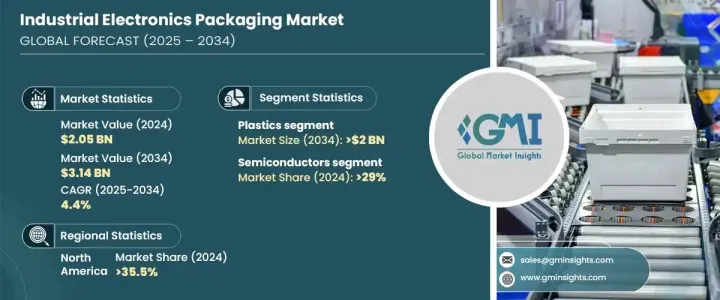
|
시장보고서
상품코드
1685125
산업용 전자기기 포장 시장 기회, 성장 촉진요인, 산업 동향 분석, 예측(2025-2034년)Industrial Electronics Packaging Market Opportunity, Growth Drivers, Industry Trend Analysis, and Forecast 2025 - 2034 |
||||||
세계의 산업용 전자기기 포장 시장은 2024년에 20억 5,000만 달러로 평가되었으며, 2025년부터 2034년까지 연평균 복합 성장률(CAGR) 4.4%를 나타내 안정적인 성장을 이룰 것으로 예상됩니다.
이 성장은 보관, 취급 및 운송 중에 섬세한 전자 부품을 보호하는 고품질의 내구성있는 포장 솔루션에 대한 수요 증가로 인한 것입니다. 세계 산업에서 첨단 전자 제품에 대한 의존도가 높아짐에 따라 깨지기 쉬운 부품을 보호하는 효율적인 포장이 필요하지 않습니다. 자동차, 통신, 자동화, 전력 시스템 등 다양한 분야에서 전자 수요의 급증은 신뢰할 수 있는 포장 솔루션의 중요성을 더욱 돋보이게 합니다. 게다가, 지속가능성에 대한 소비자의 의식이 높아짐에 따라 제조업체가 환경 친화적인 소재를 채택하도록 촉구하고 환경 친화적인 포장 선택으로의 변화를 창출하고 있습니다. 이러한 왕성한 시장 수요로 인해 재료 및 포장 기술의 혁신은 업계의 미래를 형성하는 데 중요한 역할을 계속하고 있습니다.

산업용 전자기기 포장 시장은 플라스틱, 금속, 종이, 판지 및 기타 소재로 구분됩니다. 특히 플라스틱은 현저한 성장이 예상되고, CAGR은 5%를 나타낼 것으로 예측되며, 2034년에는 20억 달러에 이를 것으로 전망됩니다. 이 플라스틱 포장 수요의 급증은 경량성, 비용 효율성, 탁월한 내구성으로 인해 산업용 전자기기로 선정되는 재료입니다. 정전기 방지 및 전도성 품종과 같은 고급 플라스틱 재료는 정전기 방전(ESD)으로부터 섬세한 부품을 보호하고 운송 중 최적의 안전을 보장하는 능력이 있기 때문에 특히 인기가 있습니다. 게다가 환경에 대한 우려가 높아짐에 따라 제조업체는 재활용 가능한 대체품 및 생분해성 대체품 등 지속 가능한 플라스틱 포장 옵션을 개발하여 세계의 환경 친화적인 대처에 보조하고 있습니다.
| 시장 범위 | |
|---|---|
| 시작 연도 | 2024년 |
| 예측 연도 | 2025-2034년 |
| 시작 금액 | 20억 5,000만 달러 |
| 예측 금액 | 31억 4,000만 달러 |
| CAGR | 4.4% |
이 시장은 또한 반도체, 전력 전자, 산업용 제어 시스템, 통신 기기, 자동화·로봇 장비 등을 포함한 주요 응용 분야로 나뉩니다. 2024년에는 반도체 분야가 29%라는 큰 시장 점유율을 차지했으며, 이는 반도체 산업의 급성장에 의한 동향입니다. IoT 장비, 5G 네트워크, AI 기술의 보급으로 정교한 전자 부품의 요구가 증가하고 있으며 취급 시나 운송 시 손상을 방지하기 위해 안전하게 포장해야 합니다.
북미의 산업용 전자기기 포장 시장은 2024년 세계 점유율의 35.5%를 차지했으며 미국이 크게 공헌했습니다. 이 지역에서는 자동화, 첨단 전자 및 스마트 기술에 대한 수요가 높아지고 있으며, 각 제조업체는 제품 보호를 보장하는 견고한 포장 재료를 찾고 있습니다. 게다가 지속가능한 포장 솔루션이 중요해지면서 기업은 친환경적인 선택을 추구하고 규제기준과 지속가능성 목표를 충족할 수 있게 되었습니다. RFID 추적 및 환경 센서를 포함한 스마트 포장 기술은 공급망 가시성, 제품 추적성, 전반적인 업무 효율성을 향상시키는 데 점점 더 중요해지고 있습니다. 업계가 혁신과 확장을 계속하면서, 이러한 기술은 시장 발전에 중요한 역할을 할 것으로 기대됩니다.
목차
제1장 조사 방법과 조사 범위
- 시장 범위와 정의
- 기본 추정과 계산
- 예측 계산
- 데이터 소스
제2장 주요 요약
제3장 업계 인사이트
- 생태계 분석
- 밸류체인에 영향을 주는 요인
- 파괴적 혁신
- 향후 전망
- 제조업체
- 유통업체
- 이익률 분석
- 주요 뉴스와 대처
- 규제 상황
- 영향요인
- 성장 촉진요인
- 반도체 산업과 그 응용 분야의 확대
- 전자기기 부문의 성장
- 전기자동차(eV) 수요의 급증
- 로봇 공학과 산업 자동화 시스템의 성장
- 자동차 산업의 성장
- 업계의 잠재적 위험 및 과제
- 첨단 기술과의 호환성
- 원재료 비용 상승
- 성장 촉진요인
- 성장 가능성 분석
- Porter's Five Forces 분석
- PESTEL 분석
제4장 경쟁 구도
- 서론
- 기업 점유율 분석
- 경쟁 포지셔닝 매트릭스
- 전략 전망 매트릭스
제5장 시장 추계·예측 : 재료 유형별(2021-2034년)
- 주요 동향
- 플라스틱
- 금속
- 종이 및 판지
- 기타
제6장 시장 추계·예측 : 제품 유형별(2021-2034년)
- 주요 동향
- 트레이
- 튜브
- 가방 및 파우치
- 박스 및 케이스
- 랙 및 캐비닛
- 기타
제7장 시장 추계·예측 : 보호 레벨별(2021-2034년)
- 주요 동향
- 표준 포장
- 정전기 방전 포장
- 전자기 간섭 차폐
- 밀폐 포장
- 기타
제8장 시장 추계·예측 : 용도별(2021-2034년)
- 주요 동향
- 반도체
- 전력 전자
- 산업용 제어 시스템
- 통신 기기
- 자동화 및 로봇 장비
- 기타
제9장 시장 추계·예측 : 지역별(2021-2034년)
- 주요 동향
- 북미
- 미국
- 캐나다
- 유럽
- 영국
- 독일
- 프랑스
- 이탈리아
- 스페인
- 러시아
- 아시아태평양
- 중국
- 인도
- 일본
- 한국
- 호주
- 라틴아메리카
- 브라질
- 멕시코
- 중동 및 아프리카
- 남아프리카
- 사우디아라비아
- 아랍에미리트(UAE)
제10장 기업 프로파일
- Achilles
- Botron
- Delphon
- Desco
- Dou Yee
- DS Smith
- Ferrari Packaging
- GWP
- Nefab
- Protective Packaging
- Protective Packaging Solutions
- Schott
- Sealed Air
- Smurfit Kappa
- Teknis
- Toppan
- Universal Protective Packaging
- Xpertpack
The Global Industrial Electronics Packaging Market, valued at USD 2.05 billion in 2024, is expected to experience steady growth at a CAGR of 4.4% from 2025 to 2034. This growth can be attributed to the increasing demand for high-quality, durable packaging solutions that protect sensitive electronic components during storage, handling, and transportation. As industries across the globe rely more heavily on advanced electronics, the need for efficient packaging that safeguards fragile components has never been more critical. The surge in demand for electronics in various sectors, including automotive, telecommunications, automation, and power systems, has further highlighted the importance of reliable packaging solutions. In addition, rising consumer awareness about sustainability is driving manufacturers to adopt eco-friendly materials, creating a shift toward more environmentally conscious packaging choices. With such a strong market demand, innovations in materials and packaging technologies continue to play a significant role in shaping the future of the industry.

The industrial electronics packaging market is segmented into plastics, metals, paper & board, and other materials. Plastics, in particular, are expected to see a notable growth trajectory, with a projected CAGR of 5% that will bring the segment to a value of USD 2 billion by 2034. This surge in plastic packaging demand is driven by its lightweight nature, cost-efficiency, and exceptional durability, making it the material of choice for industrial electronics. Advanced plastic materials, such as anti-static and conductive varieties, are particularly popular due to their ability to protect sensitive components from electrostatic discharge (ESD), ensuring optimal safety during transit. Furthermore, growing environmental concerns have prompted manufacturers to develop sustainable plastic packaging options, such as recyclable and biodegradable alternatives, aligning with global eco-friendly initiatives.
| Market Scope | |
|---|---|
| Start Year | 2024 |
| Forecast Year | 2025-2034 |
| Start Value | $2.05 Billion |
| Forecast Value | $3.14 Billion |
| CAGR | 4.4% |
The market is further divided into key application areas, including semiconductors, power electronics, industrial control systems, telecommunications equipment, automation and robotics equipment, and others. In 2024, the semiconductor segment commanded a significant 29% market share, a trend driven by the rapid growth of the semiconductor industry. The widespread adoption of IoT devices, 5G networks, and AI technologies has intensified the need for sophisticated electronic components, which must be packaged securely to avoid any damage during handling and shipping.
North America's industrial electronics packaging market accounted for 35.5% of the global share in 2024, with the United States being a major contributor. The region's demand for automation, advanced electronics, and smart technology has prompted manufacturers to seek robust packaging materials that ensure the protection of their products. Additionally, a growing emphasis on sustainable packaging solutions has led companies to explore eco-friendly options, ensuring that they meet regulatory standards and sustainability goals. Smart packaging technologies, including RFID tracking and environmental sensors, are becoming increasingly important for improving supply chain visibility, product traceability, and overall operational efficiency. As the industry continues to innovate and expand, these technologies are expected to play a crucial role in the market's evolution.
Table of Contents
Chapter 1 Methodology & Scope
- 1.1 Market scope & definitions
- 1.2 Base estimates & calculations
- 1.3 Forecast calculations
- 1.4 Data sources
- 1.4.1 Primary
- 1.4.2 Secondary
- 1.4.2.1 Paid sources
- 1.4.2.2 Public sources
Chapter 2 Executive Summary
- 2.1 Industry synopsis, 2021-2034
Chapter 3 Industry Insights
- 3.1 Industry ecosystem analysis
- 3.1.1 Factor affecting the value chain
- 3.1.2 Disruptions
- 3.1.3 Future outlook
- 3.1.4 Manufacturers
- 3.1.5 Distributors
- 3.2 Profit margin analysis
- 3.3 Key news & initiatives
- 3.4 Regulatory landscape
- 3.5 Impact forces
- 3.5.1 Growth drivers
- 3.5.1.1 Expansion of the semiconductor industry and its applications
- 3.5.1.2 Growth in the consumer electronics sector
- 3.5.1.3 Surge in demand for electric vehicles (eVs)
- 3.5.1.4 Growth in robotics and industrial automation systems
- 3.5.1.5 Rising automotive industry
- 3.5.2 Industry pitfalls & challenges
- 3.5.2.1 Compatibility with advanced technologies
- 3.5.2.2 Rising raw material costs
- 3.5.1 Growth drivers
- 3.6 Growth potential analysis
- 3.7 Porter’s analysis
- 3.8 PESTEL analysis
Chapter 4 Competitive Landscape, 2024
- 4.1 Introduction
- 4.2 Company market share analysis
- 4.3 Competitive positioning matrix
- 4.4 Strategic outlook matrix
Chapter 5 Market Estimates & Forecast, By Material Type, 2021-2034 (USD Billion & Kilo Tons)
- 5.1 Key trends
- 5.2 Plastics
- 5.3 Metals
- 5.4 Paper & board
- 5.5 Others
Chapter 6 Market Estimates & Forecast, By Product Type, 2021-2034 (USD Billion & Kilo Tons)
- 6.1 Key trends
- 6.2 Trays
- 6.3 Tubes
- 6.4 Bags & pouches
- 6.5 Boxes & cases
- 6.6 Racks & cabinets
- 6.7 Others
Chapter 7 Market Estimates & Forecast, By Protection Level, 2021-2034 (USD Billion & Kilo Tons)
- 7.1 Key trends
- 7.2 Standard packaging
- 7.3 Electrostatic discharge packaging
- 7.4 Electromagnetic interference shielding
- 7.5 Hermetic packaging
- 7.6 Others
Chapter 8 Market Estimates & Forecast, By Application, 2021-2034 (USD Billion & Kilo Tons)
- 8.1 Key trends
- 8.2 Semiconductors
- 8.3 Power electronics
- 8.4 Industrial control systems
- 8.5 Telecommunications equipment
- 8.6 Automation and robotics equipment
- 8.7 Others
Chapter 9 Market Estimates & Forecast, By Region, 2021-2034 (USD Billion & Kilo Tons)
- 9.1 Key trends
- 9.2 North America
- 9.2.1 U.S.
- 9.2.2 Canada
- 9.3 Europe
- 9.3.1 UK
- 9.3.2 Germany
- 9.3.3 France
- 9.3.4 Italy
- 9.3.5 Spain
- 9.3.6 Russia
- 9.4 Asia Pacific
- 9.4.1 China
- 9.4.2 India
- 9.4.3 Japan
- 9.4.4 South Korea
- 9.4.5 Australia
- 9.5 Latin America
- 9.5.1 Brazil
- 9.5.2 Mexico
- 9.6 MEA
- 9.6.1 South Africa
- 9.6.2 Saudi Arabia
- 9.6.3 UAE
Chapter 10 Company Profiles
- 10.1 Achilles
- 10.2 Botron
- 10.3 Delphon
- 10.4 Desco
- 10.5 Dou Yee
- 10.6 DS Smith
- 10.7 Ferrari Packaging
- 10.8 GWP
- 10.9 Nefab
- 10.10 Protective Packaging
- 10.11 Protective Packaging Solutions
- 10.12 Schott
- 10.13 Sealed Air
- 10.14 Smurfit Kappa
- 10.15 Teknis
- 10.16 Toppan
- 10.17 Universal Protective Packaging
- 10.18 Xpertpack


















